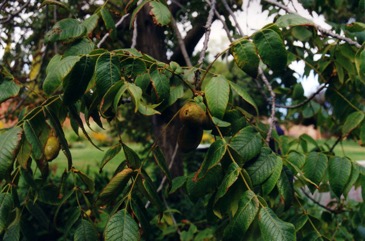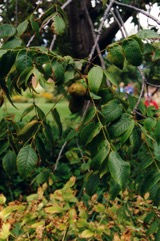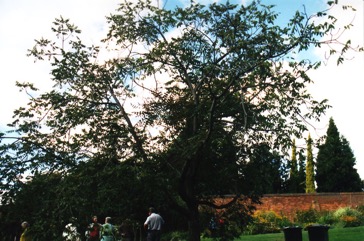Butternut, White walnut

It is a temperate plant. It is native to E. North America. They will grow in many soil conditions. They grow particularly on dry rocky soils or limestone origin. They cannot tolerate shade. In Hobart Botanical gardens. It suits hardiness zones 4-9. Arboretum Tasmania.
Also known as:
Oil nut, Lemon walnut, Sivi oreh, Wussoquat
Synonyms
- Nux cinerea (L.) M. Gomez
- Waltia cinerea (L.) Alef.
Edible Portion
- Nuts, Seeds, Sap, Seeds - oil
Where does Butternut grow?
Found in: Australia, Britain, Canada, Denmark, North America, Romania, Slovenia, Tasmania, United States
Notes: The nuts are 76% protein. There are about 30 Juglans species. All species bear edible nuts.
Growing Butternut, White walnut
Cultivation: Plants can be grown from seeds or by using cuttings of young shoots or by division.
Edible Uses: The kernels of the nuts are eaten raw. They are used in cakes, cookies and bread. They are also used to thicken porridge. The seeds yield an oil used for seasoning. The young fruit are also pickled in vinegar. The sweet sap can be boiled down to syrup or sugar and added to maple sap.
Production: Trees produce after 4 years. Trees live for 80 years. Nuts soon go rancid so must be harvested quickly after maturing.
Nutrition Info
per 100g edible portion| Edible Part | Energy (kcal) | Protein (g) | Iron (mg) | Vitamin A (ug) | Vitamin c (mg) | Zinc (mg) | % Water |
|---|---|---|---|---|---|---|---|
| Nuts | 613 | 24.9 | 4 | 12 | 3.2 | 3.1 | 3.3 |
Butternut, White walnut Photos



References
Allen, A., Growing Nuts in Australia. Night Owl Publishers. p 37
Beckstrom-Sternberg, Stephen M., and James A. Duke. "The Foodplant Database." http://probe.nalusda.gov:8300/cgi-bin/browse/foodplantdb.(ACEDB version 4.0 - data version July 1994)
Bodkin, F., 1991, Encyclopedia Botanica. Cornstalk publishing, p 595
Brickell, C. (Ed.), 1999, The Royal Horticultural Society A-Z Encyclopedia of Garden Plants. Convent Garden Books. p 573
Brown, D., 2002, The Royal Horticultural Society encyclopedia of Herbs and their uses. DK Books. p 247
Cheifetz, A., (ed), 1999, 500 popular vegetables, herbs, fruits and nuts for Australian Gardeners. Random House p 197
Coombes, A.J., 2000, Trees. Dorling Kindersley Handbooks. p 184
Cundall, P., (ed.), 2004, Gardening Australia: flora: the gardener's bible. ABC Books. p 769
Elias, T.S. & Dykeman P.A., 1990, Edible Wild Plants. A North American Field guide. Sterling, New York p 247
Esperanca, M. J., 1988. Surviving in the wild. A glance at the wild plants and their uses. Vol. 1. p 159
Etherington, K., & Imwold, D., (Eds), 2001, Botanica's Trees & Shrubs. The illustrated A-Z of over 8500 trees and shrubs. Random House, Australia. p 407
Facciola, S., 1998, Cornucopia 2: a Source Book of Edible Plants. Kampong Publications, p 124
FAO, 1995, Edible Nuts. Non Wood Forest Products 5.
Farrar, J.L., 1995, Trees of the Northern United States and Canada. Iowa State University press/Ames p 198
Flowerdew, B., 2000, Complete Fruit Book. Kyle Cathie Ltd., London. p 196
Glowinski, L., 1999, The Complete Book of Fruit Growing in Australia. Lothian. p 93
Gouldstone, S., 1983, Growing your own Food-bearing Plants in Australia. Macmillan p 136
Grandtner, M. M., 2008, World Dictionary of Trees. Wood and Forest Science Department. Laval University, Quebec, Qc Canada. (Internet database http://www.wdt.qc.ca)
Hedrick, U.P., 1919, (Ed.), Sturtevant's edible plants of the world. p 362
http://www.botanic-gardens-ljubljana.com/en/plants
Jackes, D. A., Edible Forest Gardens
Kiple, K.F. & Ornelas, K.C., (eds), 2000, The Cambridge World History of Food. CUP p 1876
Little, E.L., 1980, National Audubon Society Field Guide to North American Trees. Alfred A. Knopf. p 356
Lyle, S., 2006, Discovering fruit and nuts. Land Links. p 255
MacKinnon, A., et al, 2009, Edible & Medicinal Plants of Canada. Lone Pine. p 63
Menninger, E.A., 1977, Edible Nuts of the World. Horticultural Books. Florida p 8
Moerman, D. F., 2010, Native American Ethnobotany. Timber Press. p 279
Plants for a Future database, The Field, Penpol, Lostwithiel, Cornwall, PL22 0NG, UK. http://www.scs.leeds.ac.uk/pfaf/
Syst. nat. ed. 10, 2:1273. 1759
USDA, ARS, National Genetic Resources Program. Germplasm Resources Information Network - (GRIN). [Online Database] National Germplasm Resources Laboratory, Beltsville, Maryland. Available: www.ars-grin.gov/cgi-bin/npgs/html/econ.pl (10 April 2000)
van Wyk, B., 2005, Food Plants of the World. An illustrated guide. Timber press. p 219
Wickens, G.E., 1995, Edible Nuts. FAO Non-wood forest products. FAO, Rome. p 48, 136
World Checklist of Useful Plant Species 2020. Royal Botanic Gardens, Kew